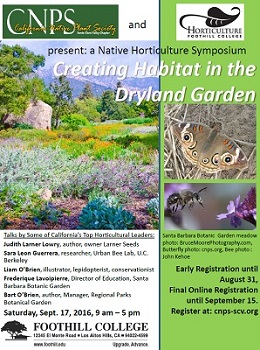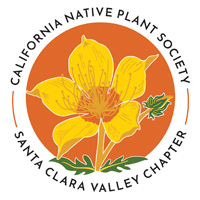Creating Habitat in the Dryland Garden 
The symposium was held on Saturday, September 17, 2016, from 9:00 a.m. to 5:00 p.m. at Foothill College in Los Altos Hills.
Landscaping with California native plants is a proven technique for creating low-water, low-maintenance gardens that also provide refuge for wildlife and repair the damage to our urban and suburban areas. As gardeners, we appreciate pretty flowers and beautiful greenery, but a garden can also provide movement by feeding and housing our fellow creatures. Watching hummingbirds nectar, seeing a caterpillar grow and change, and viewing baby birds as they leave their nest for the first time are delightful experiences that transform how we view our gardens’ role within the local ecosystem.
Videos of the presentations at the 2016 symposium are linked below:
- The Importance of Being Local for Habitat and Design: Judith Larner Lowry, author and owner of Larner Seeds, talks about the deep reasons to use locally native plants in the habitat garden from the perspectives of the purist, the bees, and the designer.
- Native Bees Need You!: Sara Leon Guerrero, researcher at the Urban Bee Lab, U.C. Berkeley, describes how native pollinators benefit our gardens, showing some of the most common local bees with their favorite nectar and pollen-rich plants to grow in your garden.
- The Butterflies of San Francisco: How They Relate to Your Garden: Liam O’Brien, illustrator, lepidopterist, and conservationist, describes the butterflies in the tiny geographical area of San Francisco.
- Hedgerows as Habitat: Frederique Lavoipierre, Director of Education at the Santa Barbara Botanic Garden, shows how you can take a boring, monoculture hedge and transform it into a magnet for wildlife.
- Designing your Habitat Garden: Bart O’Brien, author and Manager, Regional Parks Botanic Garden, describes easy, practical steps which you can take now to create a landscape rich in wildlife and movement.

